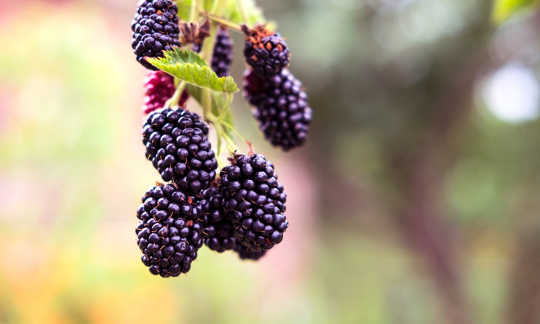 The Himalayan blackberry was introduced to North America as a food crop. Like a Gremlin doused with water, it escaped its confinement and rampantly spread throughout the continent.
The Himalayan blackberry was introduced to North America as a food crop. Like a Gremlin doused with water, it escaped its confinement and rampantly spread throughout the continent.
Blackberries are perhaps the best known of all foraged wild fruits. Whether they grow modestly on the perimeters of a ramshackle farm or thrive ruthlessly along the banks of a forgotten creek, there are hundreds of hidden wild blackberry havens waiting for opportunistic berry fanatics.
Blackberries exist to lure the weak-willed away from the straight-and-narrow path. Their thorns will scratch, and the company they keep can hurt you. Everything flanking straight-and-narrow paths is bound to be interesting, so I say go for it, but I do have a cautionary tale.
Years ago I had just moved to California and was happily exploring the town of Sonoma, where I had recently set up in a little apartment. I discovered a bike path and trails branching off it into the hills, where my running route wound through madrone groves and next to vineyards. In those days I ran for hours and hours under the blare of the midday summer sun, and it made me a little loopy. When I noticed blackberry brambles not far off the bike path, I got right up in them and gobbled up berries to rehydrate. What I didn’t notice in my frenzy was poison oak—blackberries have an affinity for it, as tomatoes do with basil—and the back of my hand must have grazed a cluster right before I used that same hand to wipe giant beads of perspiration off my face.
A week later I had a robust breakout of seeping poison oak blisters on my upper lip. The ooze of the blisters would dry into a crust the color of light amber. It took all of my willpower not to pick at it constantly. While so afflicted, I met Julia Child at a book signing. As she kindly inscribed my copy of Baking with Julia and offered earnest advice about a career in food writing, all I could think of was my marred face.
If I had not contracted that poison oak, perhaps I’d have been more receptive to Julia Child’s career insights and not floundered around for years working crummy retail jobs and scrounging for oddball freelance gigs. But I’d not be who I am today. And guess what—I still get rashes from overenthusiastically taking off after trailside fruit! I have learned nothing!
The blackberries in question were undoubtedly the invasive Himalayan blackberry brambles that overrun hillsides and choke out native species, but that does not mean the fruit of these dominating opportunists cannot be harvested and eaten with aplomb (just look out for poison oak or poison ivy). Himalayan blackberries (R. armeniacus) are not prized for their flavor—I find them sour and wan, though if you’re in the middle of running 12 miles (19 km) they hit the spot like nothing else. And if you come across a lot of them, there’s always our good friend sugar to make them more palatable.
Disappointingly, the Himalayan blackberry is not from the Himalayas. It originated in Armenia and was introduced to Europe in 1835 for people to cultivate as a crop on purpose, if you can believe that. Like a gremlin doused with water, it escaped its confinement and rampantly spread throughout the continent. America’s own beloved plant maestro Luther Burbank introduced it in America in 1885, likely with no suspicion of how aggressively it would take root all up and down the West Coast. Burbank’s aim was to develop fruit and vegetable plants that would withstand long periods of shipping—this was when our nation’s transcontinental transportation network was coming into its tween years—so residents of our increasingly urbanized cities could have access to fresh produce. It’s Burbank who named it the Himalaya Giant, for the size of the berries. He sold the seeds through his seed catalog.
Feral Himalayan blackberries are deeply intertwined with the cultural identity of modern residents of California and the Pacific Northwest. The thickets are everywhere, at once loved and loathed. Tom Robbins set his 1980 novel Still Life with Woodpecker in a Seattle suburb where an exiled king and his family live in a house surrounded with a natural barricade of blackberries. Homeowners and naturalists engage in a never-ending battle with its burly, snaggy tendrils. My brother, who does non-native plant removal, owes his livelihood in part to Himalayan blackberries.
And yet there are the berries themselves, a seasonal token of redemption for the Rubus armeniacus, a plant impossible to eradicate. Therefore, we must coexist. If the truce lasts only as long as the berries, so be it.
Of course, there are hundreds of varieties of blackberries, native and crossbred. Some have thorns; others don’t. Blackberries and raspberries both belong to the genus Rubus. Think of them as the patriarch and matriarch of the bramble clan. The extended family of Rubus pedigrees (boysenberries, loganberries, tayberries) are considered blackberries regardless of their color, because once picked, they retain their firm white core (or receptacle); raspberries don’t. This receptacle is why blackberries have a longer shelf life than raspberries—they don’t crush as easily.
Late summer is the time for blackberries. Farmed crops start coming into season in the middle of June, but the best wild berries don’t start appearing until July, with holdouts ripening into September. An old English folktale warns against picking blackberries after the fall, when the devil makes a mark on their leaves and claims them as his own, although in reality it’s more likely birds would have claimed the berries by then anyway.
Gathering fresh blackberries is not without its perils—insects, blazing sun, scratchy weeds—but the rewards are many. Few activities tap so directly into the spirit of summer.
Native to Asia, Europe, and North and South America, blackberries can be found growing on all continents except Antarctica. In Europe and in North America, blackberries have been used for medicinal purposes for hundreds of years; various preparations of blackberry juice, leaves, and bark were said to soothe eye and mouth ailments, aid digestion, relieve toothaches, and remedy dysentery. Today the focus is more on blackberries’ nutritional value: They are rich in antioxidants and dietary fiber.
Harvesting and Storage
Ripe blackberries are deep, dark purple-black—not purple, and certainly not red or green. Berries on a given plant ripen in stages, offering opportunities to revisit a patch to replenish supplies as the weeks pass. Blackberries ripen only on the branch and will not become sweeter during storage. When picked, a ripe blackberry should come free of the plant with nothing more than a gentle nudge. Watch out for thorns, too; not all blackberry bushes have them, but most wild ones do.
Once picked, blackberries don’t hold up very long. Blackberries kept at room temperature may mold quickly, so refrigerate them 3 to 4 days, tops; as the blackberries age, they lose their sheen and plumpness, taking on a slightly withered, matte look. Like most other berries, wash them directly prior to eating and no earlier; a premature rinse will lead to mushy berries.
Culinary Possibilities
Barring an all-out bonanza of fresh berry eating, there are two ways to make good on a prodigious blackberry harvest. One is to launch into a frenzy of canning; the other, which is less demanding and more versa- tile, is to freeze the berries. You don’t need pectin to make jam, but many like to add it. Soft or squishy berries that are still good flavorwise are a smart addition to shrubs, sangria, sorbet, compotes, or anything saucy.
Balsamic Blackberry Compote
Makes about 2 cups (480 ml)
Showcase the last berries of summer in a simple spiced compote set off with a drizzle of balsamic. Serve this on rice pudding, panna cotta, or plain yogurt.
3 cups (435 g) blackberries?
3 tablespoons granulated sugar?
1?4 teaspoon cinnamon?
Pinch ground nutmeg?
1?2 teaspoon finely grated lemon zest
1?2 teaspoon balsamic vinegar
Combine all the ingredients from the berries through the zest in a medium skillet over medium heat. Cook, stirring occasionally, until the berries release their liquid. Simmer 1 to 3 minutes to reduce a little, then crush with a potato masher, leaving half of berries intact. Add the vinegar, and remove from the heat. Serve warm, cold, or at room temperature. Refrigerated, the compote will keep for 1 week.
This excerpt is adapted from Sara Bir’s book The Fruit Forager’s Companion: Ferments, Desserts, Main Dishes, and More from Your Neighborhood and Beyond (Chelsea Green, 2018) and is printed with permission from the publisher.
This article originally appeared on YES! Magazine
About The Author
Sara Bir is a chef and a writer. A graduate of The Culinary Institute of America, she creates recipes that draw on her professional skill set, yet are realistic for home cooks. Bir has worked as a chocolate factory tour guide, sausage-cart lackey, food editor, recipe tester, restaurant critic, librarian, and arts and entertainment reporter. In her spare time, she enjoys walking around and looking at plants. Bir’s writing has been featured in Saveur, Edible Ohio Valley, Best Food Writing 2014, two Full Grown People anthologies, and on the websites Serious Eats, Lucky Peach, and Paste Magazine. She lives in Ohio.
Related Books:
at InnerSelf Market and Amazon

























